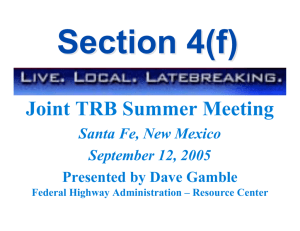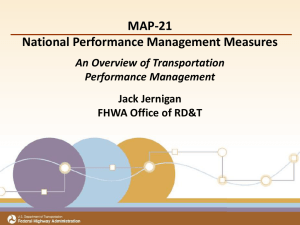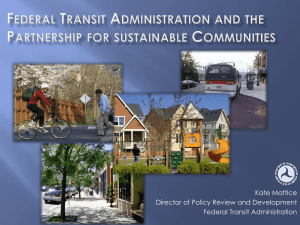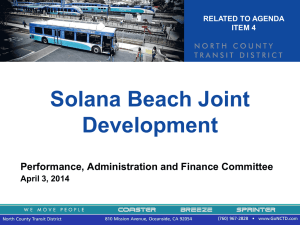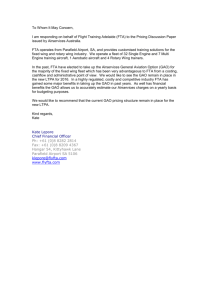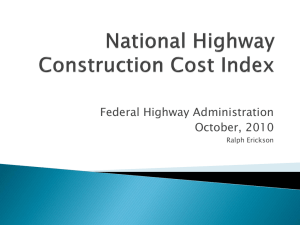Joint FHWA/FTA Interim Guidance
advertisement
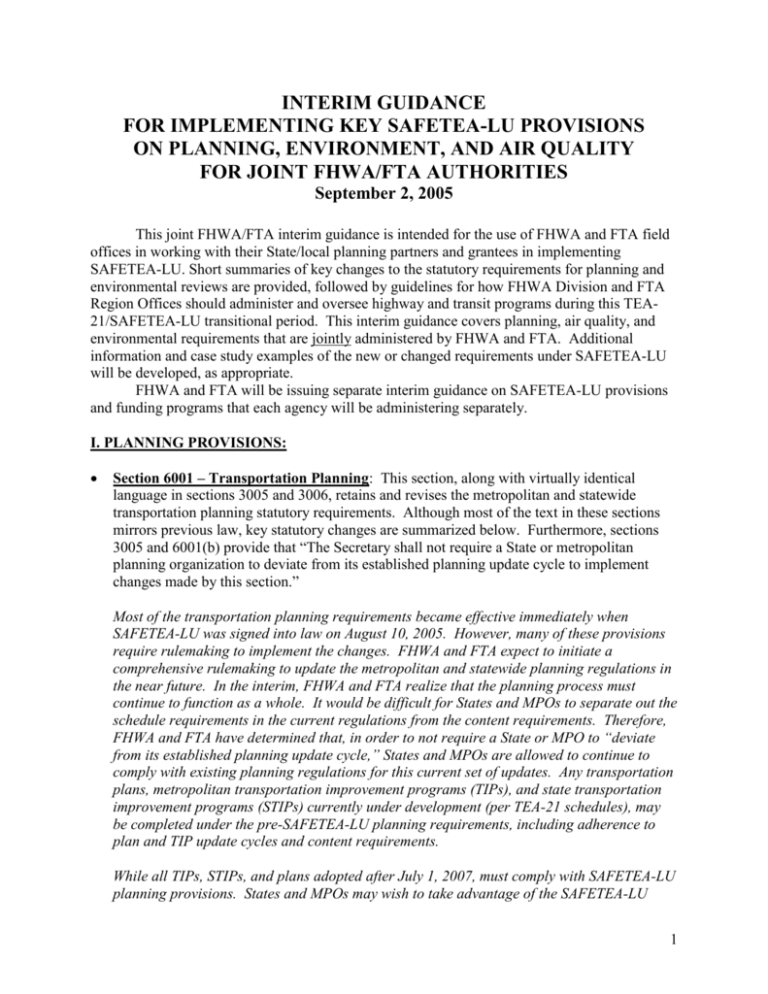
INTERIM GUIDANCE FOR IMPLEMENTING KEY SAFETEA-LU PROVISIONS ON PLANNING, ENVIRONMENT, AND AIR QUALITY FOR JOINT FHWA/FTA AUTHORITIES September 2, 2005 This joint FHWA/FTA interim guidance is intended for the use of FHWA and FTA field offices in working with their State/local planning partners and grantees in implementing SAFETEA-LU. Short summaries of key changes to the statutory requirements for planning and environmental reviews are provided, followed by guidelines for how FHWA Division and FTA Region Offices should administer and oversee highway and transit programs during this TEA21/SAFETEA-LU transitional period. This interim guidance covers planning, air quality, and environmental requirements that are jointly administered by FHWA and FTA. Additional information and case study examples of the new or changed requirements under SAFETEA-LU will be developed, as appropriate. FHWA and FTA will be issuing separate interim guidance on SAFETEA-LU provisions and funding programs that each agency will be administering separately. I. PLANNING PROVISIONS: Section 6001 – Transportation Planning: This section, along with virtually identical language in sections 3005 and 3006, retains and revises the metropolitan and statewide transportation planning statutory requirements. Although most of the text in these sections mirrors previous law, key statutory changes are summarized below. Furthermore, sections 3005 and 6001(b) provide that “The Secretary shall not require a State or metropolitan planning organization to deviate from its established planning update cycle to implement changes made by this section.” Most of the transportation planning requirements became effective immediately when SAFETEA-LU was signed into law on August 10, 2005. However, many of these provisions require rulemaking to implement the changes. FHWA and FTA expect to initiate a comprehensive rulemaking to update the metropolitan and statewide planning regulations in the near future. In the interim, FHWA and FTA realize that the planning process must continue to function as a whole. It would be difficult for States and MPOs to separate out the schedule requirements in the current regulations from the content requirements. Therefore, FHWA and FTA have determined that, in order to not require a State or MPO to “deviate from its established planning update cycle,” States and MPOs are allowed to continue to comply with existing planning regulations for this current set of updates. Any transportation plans, metropolitan transportation improvement programs (TIPs), and state transportation improvement programs (STIPs) currently under development (per TEA-21 schedules), may be completed under the pre-SAFETEA-LU planning requirements, including adherence to plan and TIP update cycles and content requirements. While all TIPs, STIPs, and plans adopted after July 1, 2007, must comply with SAFETEA-LU planning provisions. States and MPOs may wish to take advantage of the SAFETEA-LU 1 provisions prior to July 1, 2007, and they are encouraged to do so. If a State or MPO opts to implement the SAFETEA-LU planning provisions prior to July 1, 2007, they must meet all SAFETEA-LU requirements in Section 6001, since the various provisions are closely interrelated. If plans and TIPs are prepared under the new update cycle described below, they must also comply with the expanded scope, consultation, mitigation, and participation requirements set forth in SAFETEA-LU. In addition, in no instance should the next update of a STIP or TIP be more than 4 years from the most recent update. Implementation of the new 4-year cycle allowed for FHWA/FTA certification of planning processes in Transportation Management Areas (TMAs) is the responsibility of the FHWA/FTA field offices and can take place immediately under certain circumstances, as discussed below. We have provided some basic guidance below for those States and MPOs that opt to implement SAFETEA-LU immediately. Metropolitan Plan Cycles: Metropolitan transportation plans shall be updated at least every four years in air quality nonattainment and maintenance areas, and at least every five years in attainment areas. To align the MPO adoption of the transportation plan in nonattainment and maintenance areas and conformity determinations, the date of the FHWA/FTA conformity determination on the transportation plan is to be used as the basis for tracking update cycles in nonattainment and maintenance areas. TIP/STIP Cycles and Scope: STIPs and metropolitan TIPs must be updated at least every 4 years and must contain at least 4 years of projects and strategies. The 4-year frequency cycle and the 4-year scope requirements go hand-in-hand and must be implemented together, for any STIP or metropolitan TIP adopted after July 1, 2007. Metropolitan and Statewide Plans –Environmental Mitigation: Metropolitan and statewide transportation plans must include a discussion of types of potential environmental mitigation activities, to be developed in consultation with Federal, State and Tribal wildlife, land management, and regulatory agencies. Details on these “discussions of types of potential environmental mitigation activities” are outlined in amended 23 U.S.C. 134(i)(2)(B) and 23 U.S.C. 135(f)(4), respectively, based on the consultation requirements highlighted below. Identical provisions for transit appear in the amended 49 U.S.C. 5303(i)(2)(B) and 49 U.S.C. 5304(f)(4). The environmental mitigation requirement must be in place prior to MPO and State adoption/approval of transportation plans addressing SAFETEA-LU provisions. New Consultations: MPOs and States must consult “as appropriate” with “State and local agencies responsible for land use management, natural resources, environmental protection, conservation, and historic preservation” in developing long-range transportation plans. Additionally for the Long-Range Statewide Transportation Plan, States must consult with Federally-recognized Tribal agencies responsible for land use management, natural resources, environmental protection, conservation, and historic preservation. These new requirements must be in place prior to MPO and State adoption/approval of transportation 2 plans addressing SAFETEA-LU provisions. Details for metropolitan and statewide planning are outlined in the amended 23 U.S.C. 134(i)(4) and 23 U.S.C. 135(f)(2)(D), respectively, and for transit, in the amended 49 U.S.C. 5303(i)(4) and 49 U.S.C. 5304(f)(2)(D). Consistency of Transportation Plan with Planned Growth and Development Plans: Revises the previous planning factor related to environment to add “promot[ing] consistency between transportation improvements and State and local planned growth and economic development patterns.” This new requirement must be in place prior to MPO and State adoption/approval of transportation plans addressing SAFETEA-LU provisions. Transportation System Security: SAFETEA-LU calls for the security of the transportation system to be a stand-alone planning factor, signaling an increase in importance from prior legislation, in which security was coupled with safety in the same planning factor. This new requirement must be in place prior to MPO and State adoption/approval of transportation plans addressing SAFETEA-LU provisions. Operational and Management Strategies: Metropolitan transportation plans shall include operational and management strategies to improve the performance of the existing transportation facilities to relieve vehicular congestion and maximize the safety and mobility of people and goods (see amended 23 U.S.C. 134(i)(2)(D)) and 49 U.S.C. 5303(i)(2)(D)). The requirement for the inclusion of operational and management strategies must be in place prior to MPO adoption of transportation plans addressing SAFETEA-LU provisions. Participation Plan: MPOs must develop and utilize a “Participation Plan” that provides reasonable opportunities for interested parties to comment on the content of the metropolitan transportation plan and metropolitan TIP. Further, this “Participation Plan” must be developed “in consultation with all interested parties”. This consultation requirement is intended to afford parties who participate in the metropolitan planning process a specific opportunity to comment on the plan prior to its approval. A participation plan must be in place prior to MPO adoption of transportation plans and TIPs addressing SAFETEA-LU provisions. FTA/FHWA particularly expect this to encompass governmental and nonprofit organizations that receive Federal assistance from a source other than the Department of Transportation to provide non-emergency transportation services and recipients of assistance under section 204 of title 23, U.S.C. Visualization Techniques in Plans and Metropolitan TIP Development: As part of transportation plan and TIP development, MPOs shall employ visualization techniques (see amended 23 U.S.C. 134(i)(5)(C)(ii)) and 49 U.S.C. 5303(i)(5)(C)(ii)). States shall also employ visualization techniques in the development of the Long-Range Statewide Transportation Plan (see amended 23 U.S.C. 135(f)(3)(B)(ii)) and 49 U.S.C. 5304(f)(3)(B)(ii)). States and MPOs must employ visualization techniques prior to adoption of statewide and metropolitan transportation plans and metropolitan TIPs addressing SAFETEA-LU provisions. Publication of Plans and TIP/STIP: MPOs shall publish or otherwise make available for public review transportation plans and TIPs “including (to the maximum extent practicable) 3 in electronically accessible formats and means, such as the World Wide Web” (see amended 23 U.S.C. 134(i)(6) on plans and 23 U.S.C. 134(j)(7)(a) on TIPs, and for transit, amended 49 U.S.C. 5303(i)(6) and 49 U.S.C. 5303(j)(7)(a)). States also shall use a similar approach for the Long-Range Statewide Transportation Plan (see amended 23 U.S.C. 135(f)(8)) and 49 U.S.C. 5304(f)(8)). These publication requirements must be in place prior to adoption of transportation plans and TIPs addressing SAFETEA-LU provisions. Annual Listing of Obligated Projects: SAFETEA-LU specifies that the development of the annual listing “shall be a cooperative effort of the State, transit operator, and MPO” and also shall include two new project types, “investments in pedestrian walkways and bicycle transportation facilities” for which Federal funds have been obligated in the preceding year. This revised requirement for an annual listing must be in place prior to adoption of transportation plans and programs addressing SAFETEA-LU. Congestion Management Processes in Transportation Management Areas (TMAs): Within a metropolitan planning area serving a TMA, there must be “a process that provides for effective management and operation” to address congestion management (see amended 23 U.S.C. 134(k)(3)) and 49 U.S.C. 5303(k)(3)). This provision is similar to the ISTEA/TEA21 requirement for a Congestion Management System (CMS) to be developed and implemented in TMAs. Each TMA (with input from the FHWA Division Offices and FTA Regional Offices) should assess the extent that the TMA’s existing CMS meets the new statutory requirements for a congestion management process under amended 23 U.S.C. 134(k)(3) and 49 U.S.C. 5303(k)(3) and define a plan and schedule to implement this process. Consistent with previous FHWA/FTA guidance, the phase-in schedule for this provision in newly designated TMAs is 18 months after the identification of a TMA. TMA Certification Cycle: FHWA/FTA must certify each TMA planning process at least every four years (as opposed to the prior legal/statutory requirement of every three years). This provision is effective immediately and allows FTA/FHWA to add one year to existing TMA certifications. The only exception is “conditional certifications” issued for a TMA, which must be completed in accordance with the schedule previously defined by the FHWA Division Office and FTA Regional Office. The timing for certification reviews remains a joint FTA/FHWA decision, and SAFETEA-LU extends the minimum allowable frequency to "at least every 4 years." This does not preclude FTA/FHWA from initiating a Certification Review more frequently and at any time it is warranted. The status and quality of MPOs' Plan and TIP development, the potential for conformity lapse, and other MPO performance indicators should be considered by FTA/FHWA in deciding whether to delay (as allowed under SAFETEA-LU), or accelerate, Certification Reviews. Coordinated Public Transit-Human Services Transportation Plan (Sections 3012, 3018, and 3019): As a condition for receiving formula funding under the following 3 FTA programs, proposed projects must be derived from a locally developed public transit-human services transportation plan: (1) Special Needs of Elderly Individuals and Individuals with Disabilities [49 U.S.C. 5310(d)(2)(B)(i) and (ii)]; (2) Job Access and Reverse Commute [49 U.S.C. 5316(g)(3)(A) and (B)]; and (3) New Freedom [49 U.S.C. 5317(f)(3)(A) and (B)]. The plan must have been developed through a process that included representatives of public, 4 private, and non profit transportation and human services providers, as well as the public. This new requirement reinforces the broadened list of entities to be involved in the MPO’s Participation Plan (23 U.S.C. 134 (i)(5)(A) and 49 U.S.C. 5303 (i)(5)(A)), as described above. In preparing the local public transit-human service transportation plans, service providers seeking assistance under these programs should ensure full coordination with the applicable metropolitan and statewide planning processes. Headquarters Contacts for Questions or Comments on Planning Provisions: John Humeston or Harlan Miller in HEPP or Charlie Goodman in TPE. II. AIR QUALITY PROVISIONS Section 6011 – Transportation Conformity: Makes several changes to the transportation conformity process including: a 12 months conformity lapse grace period; a change in the update frequency cycle to 4 years; a conformity redetermination on existing transportation plans and TIPs within 2 years of certain actions on the state implementation plan (SIP) for air quality; options to shorten the time horizon for conformity demonstration (but must include an informational regional emissions analysis); transportation control measure (TCM) substitution without requiring a new conformity determination or SIP revision, and adoption of substitute TCM rescinds previous TCM; and streamlined conformity SIP requirements. EPA is required to promulgate revised regulations to implement changes not later than 2 years after the enactment of SAFETEA-LU. Although the EPA is required to promulgate a rule, some or all of these provisions may be effective even before the rule is issued. We are working with EPA to develop interim guidance on how to implement these provisions while the rule is being developed. We expect to supplement this guidance document by issuing additional interim guidance in coordination with EPA as soon as possible. Headquarters Contacts for Questions or Comments: Emily Tait or Gary Jensen in HEPN or Abbe Marner in TPE. III. ENVIRONMENT PROVISIONS: Section 6002 – Efficient Environmental Reviews for Project Decisionmaking: Prescribes a new environmental review process for highway, public transportation capital, and multimodal projects. It is mandatory for EISs and optional for EAs, at the discretion of the Secretary. It specifies changes from current NEPA procedures, including new obligations for a public comment process for project Purpose and Need and for project Alternatives, and requires the development of a coordination plan and schedule that must be provided to all participating agencies and made available to the public. The provision allows States to continue operating under environmental review processes approved by the Secretary under TEA-21 authority. All 5 highway and transit EISs for which the NOI was published after 8/11/05 must follow the new process (except as provided by Section 6002(b), as described below) while highway and transit EISs for which a NOI was published prior to 8/11/05 may continue as “grandfathered” under prior law. For highway projects only, the FHWA Division and State may wish to transition ongoing EIS projects to the new process, if advantageous to the project, and where they can demonstrate that the new requirements for coordination with agencies and the public have been met through the existing project development process (i.e., interagency merger agreements, public workshops that included early identification of purpose and need and alternatives, etc). Under Section 6002(b), States have the option of continuing to advance projects under processes “approved” under TEA-21’s Section 1309 authority. Please discuss with your State whether or not they would like to continue any such existing environmental review process. In such a case, please request that the State provide FHWA written documentation indicating the intent to follow previously established processes, either as a program or for individual projects. The state should include an explanation as to how the process falls under this provision. This documentation must be sufficient to stand up in court in case of a legal challenge to not following the new 6002 process. You should obtain written Headquarters concurrence before informing a State that they may follow a pre-existing environmental review process for EIS projects in lieu of following the new Section 6002 process. FHWA will be providing more comprehensive guidance on the new process for new and on-going highway EISs, as well as the application of the “existing process” provision within the next 90 days. For transit projects, FTA does not have any processes specifically approved under TEA-21’s section 1309, so the SAFETEA-LU option of grandfathering such processes is not generally helpful. For multimodal highway-transit projects for which FHWA and FTA are co-lead agencies, FTA will make every effort to follow FHWA’s lead in complying with this provision. FTA will be providing further guidance on compliance with this provision within the next 90 days. The FTA Regional office and sponsoring transit agency may transition an ongoing transit EIS to the new process, if it is deemed advantageous to the project, and if the new requirements for coordination with agencies and the public have been essentially followed during the project development process up to now. [FTA does not expect any ongoing EISs to meet these conditions, but please contact Joe Ossi in TPE if one does.] Headquarters Contacts for Questions or Comments: Pam Stephenson in HEPE or Harold Aikens in HCC or Joe Ossi in TPE. Section 6002 – Statute of Limitations: Creates 23 U.S.C. 139 (l) which, establishes a 180-day statute of limitations on litigation. However, the 180-day clock starts with publication of a notice in the Federal Register that a permit, license or approval action is final. Heretofore, notices regarding RODs and FONSIs have not been published in the Federal Register, so a new process for publication will be required. This provision is effective immediately and may be exercised independently of whether or not the new environmental review process under Section 6002 was followed. 6 For highway projects, within the next 30 days, HCC will specify a process for publishing notices of the finality of RODs and FONSIs, as well as 404 permits and possibly other Federal actions in the Federal Register, so they can benefit from this provision. It is assumed that most “approvals” (e.g., Section 106 MOAs) will be completed by RODs or FONSIs and a separate notice would not be required, unless there is a substantial lapse of time between the FHWA decision and other federal action, such as subsequent issuance of a U.S. Army Corps of Engineers permit. This provision is discretionary and should be decided on a case-by-case basis, especially for EA/FONSI documents, depending on an assessment of controversy and likelihood for litigation. The standard statute of limitation time frame of 6 years will be used for those projects, approvals or permits that do not publish the Federal Register notice. For transit projects, FTA plans to publish a Federal Register notice as soon as possible to start the 180-day clock ticking for projects with significant risk of litigation for which a ROD or FONSI has already been issued. [If you believe you have a project that should be included in this notice, please contact Joe Ossi in TPE]. Headquarters Contacts for Questions or Comments: Pam Stephenson in HEPE or Harold Aikens in HCC or Joe Ossi in TPE for transit issues. Section 6004 – State Assumption of Responsibility for Categorical Exclusions: Allows the Secretary to delegate responsibility for categorical exclusion (CE) determinations to states, subject to criteria to be established by the Secretary. Also allows for delegation of the Secretary’s responsibilities for other environmental reviews (e.g., 4(f) of the Department of Transportation Act) for projects classified as CEs. May not include delegation of governmentto-government consultation with Federally-recognized Indian tribes. US DOT is to implement this provision through individual MOUs with states, after public notice and comment. Within the next 3-4 months, FHWA and FTA will develop guidance and a template memorandum of understanding (MOU) for FHWA Divisions and FTA Regions to use in carrying out this provision. States may not use this authority for specific projects until an MOU is in place. FHWA Divisions should begin discussing with the State its preferences as to which DOT authorities it wishes to assume under this provision (e.g., CE determination, Section 4(f) approval, coordination under various Federal laws, highway CEs only or both highway and transit CEs, etc.) Our assumption is that most States will want to assume all responsibilities allowed by law for highway projects. If transit projects will also be included, the FTA Regional office must be brought into the discussion. Please note that Section 6004 permits delegation of the specified responsibilities of the Secretary only to the States, not to transit agencies that are not State agencies. FHWA Divisions should discuss the systems and procedures the State will use to assure that the Section 6004 authority is appropriately exercised. Headquarters Contacts for Questions or Comments: Owen Lindauer in HEPE or Joe Ossi in TPE for transit issues. Section 6009 – Parks, Recreation Areas, Wildlife and Waterfowl Refuges, and Historic Sites): The requirements of Section 4(f) of the Department of Transportation Act will be considered satisfied with respect to a Section 4(f) resource if it is determined that a transportation project will have only a “de minimis impact” on the 4(f) resource. The provision allows avoidance, minimization, mitigation and enhancement measures to be considered in making the 7 de minimis determination. The Agencies with jurisdiction must concur in writing with the determination. For historic properties the de minimis criteria are defined as “no adverse affect” or no "historic properties affected” under Section 106 of the National Historic Preservation Act. The de minimis criteria for parks, recreation areas and wildlife and waterfowl refuges were not clearly defined in the law but are generally minor impacts not adversely affecting the activities, features or attributes of the Section 4(f) resource. In addition, Section 6009 requires the Secretary to promulgate regulations within 1 year after the date of enactment to clarify the factors to be considered and the standards to be applied in determining the prudence and feasibility of alternatives under section 138 of title 23 and section 303 of title 49, United States Code. The de minimis provision for historic properties can be applied immediately for those projects in which a draft Section 4(f) evaluation has not been distributed. Section 106 compliance is essential to the de minimis finding and therefore, the assessment of effects should be documented on a property-by-property basis. For parks, recreation areas, wildlife and waterfowl refuges, US DOT will have to issue guidance to allow application of the de minimis provision. The process for developing the guidance is underway and is expected to be complete within one month but is subject to change depending on the need to coordinate with other agencies. Headquarters Contacts for Questions or Comments: For the de minimis provision, Lamar Smith in HEPE or Joe Ossi in TPE for transit issues. For the rulemaking, Diane Mobley in HCC, or to Scott Biehl in TCC for transit issues. Section 6010 – Environmental Review of Activities that Support Deployment of Intelligent Transportation Systems: Requires the Secretary to initiate rulemaking within 1 year to establish Intelligent Transportation System (ITS) activities as CEs, “to the extent appropriate.” This applies to multi-modal ITS projects. Also requires the Secretary to develop a national programmatic agreement for ITS and Section 106 of the National Historic Preservation Act. Most ITS activities already qualify as CEs. FHWA and FTA are not aware of delays in implementing ITS activities due to environmental reviews, including Section 106. Within US DOT, a determination will be needed as to the lead DOT agency for implementing this section, since several DOT agencies have ITS interests and responsibilities. Headquarters Contacts for Questions or Comments: Aung Gye in HEPE or Joe Ossi in TPE. 8
